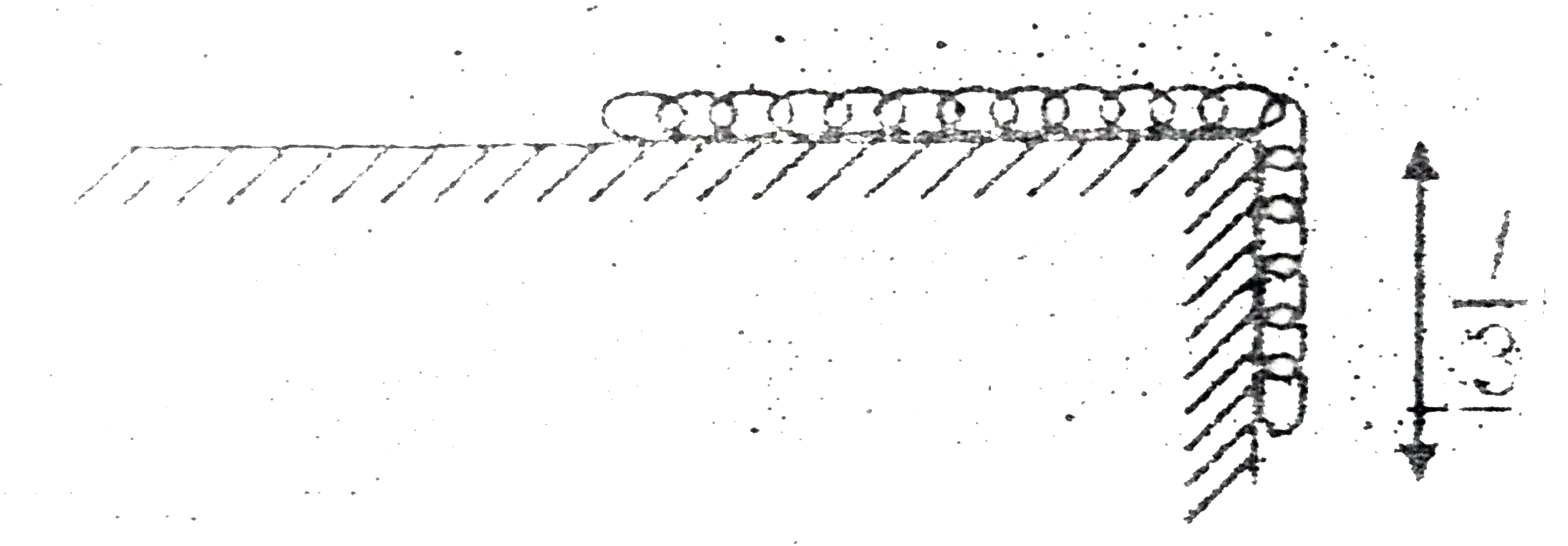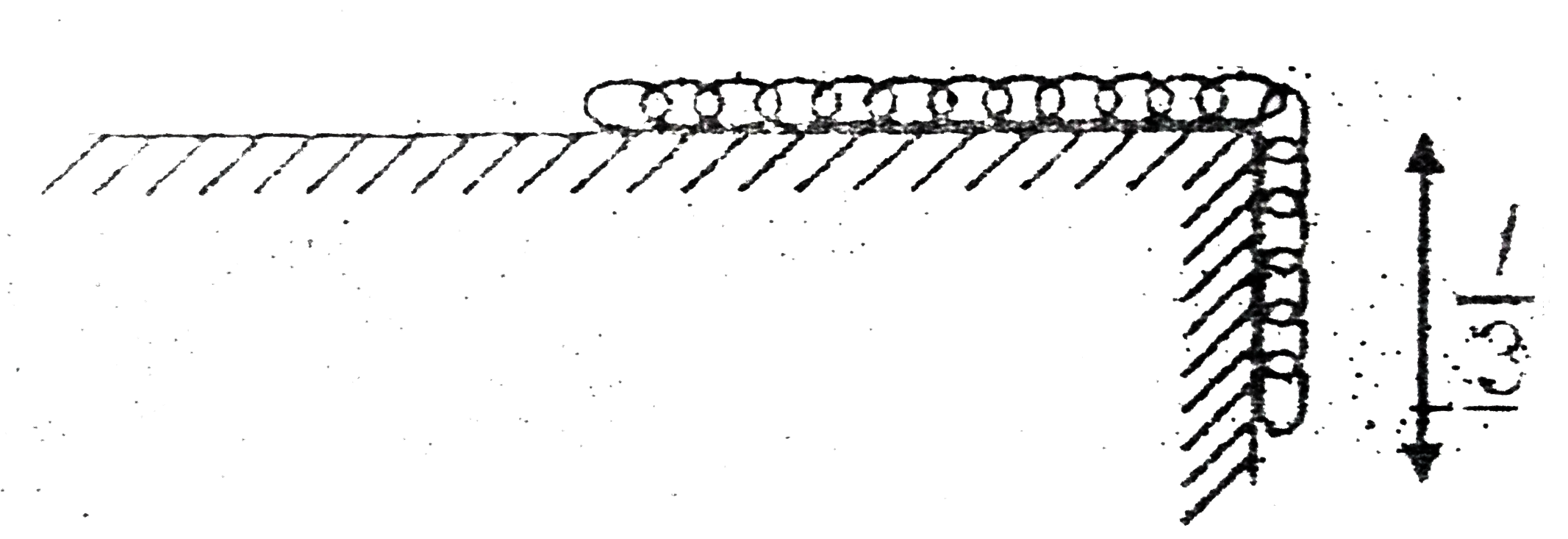A homogeneous chain lies in limiting equilibrium on a horizontal table of coefficient of friction 0.5 with part of it hanging over the edge of the table. The fractional length of the chain hanging down the edge of the table is
1/2
1/5
1/3
2/3
The correct Answer is:C
To solve the problem of finding the fractional length of a homogeneous chain hanging over the edge of a table in limiting equilibrium, we can follow these steps:
1. Understanding the Problem:
- We have a homogeneous chain lying on a horizontal table with a coefficient of friction (μ) of 0.5.
- Part of the chain is hanging off the edge of the table, and we need to find the fractional length of the chain that is hanging down.
2. Define Variables:
- Let the total length of the chain be L.
- Let the length of the chain hanging down be l.
- Therefore, the length of the chain on the table is L−l.
3. Calculate Masses:
- The total mass of the chain is M.
- The mass of the chain on the table is given by:
Mtable=ML×(L−l)=M(L−l)L
- The mass of the chain hanging down is:
Mhanging=ML×l=MlL
4. Forces Acting on the Chain:
- The force due to gravity acting on the hanging part of the chain is:
Fgravity=Mhanging⋅g=MlL⋅g
- The frictional force acting on the chain on the table is:
Ffriction=μ⋅Mtable⋅g=0.5⋅M(L−l)L⋅g
5. Setting Up the Equilibrium Condition:
- In limiting equilibrium, the frictional force equals the gravitational force:
MlL⋅g=0.5⋅M(L−l)L⋅g
- We can cancel out M and g from both sides:
lL=0.5⋅L−lL
6. Simplifying the Equation:
- Rearranging gives:
l=0.5(L−l)
- Expanding this:
l=0.5L−0.5l
- Bringing all terms involving l to one side:
l+0.5l=0.5L
1.5l=0.5L
7. Solving for l:
- Dividing both sides by 1.5:
l=0.5L1.5=L3
8. Finding the Fractional Length:
- The fractional length of the chain hanging down is:
lL=L/3L=13
Final Answer:
The fractional length of the chain hanging down the edge of the table is 13.
- We have a homogeneous chain lying on a horizontal table with a coefficient of friction (μ) of 0.5.
- Part of the chain is hanging off the edge of the table, and we need to find the fractional length of the chain that is hanging down.
- Let the total length of the chain be L.
- Let the length of the chain hanging down be l.
- Therefore, the length of the chain on the table is L−l.
- The total mass of the chain is M.
- The mass of the chain on the table is given by:
Mtable=ML×(L−l)=M(L−l)L
- The mass of the chain hanging down is:
Mhanging=ML×l=MlL
- The force due to gravity acting on the hanging part of the chain is:
Fgravity=Mhanging⋅g=MlL⋅g
- The frictional force acting on the chain on the table is:
Ffriction=μ⋅Mtable⋅g=0.5⋅M(L−l)L⋅g
- In limiting equilibrium, the frictional force equals the gravitational force:
MlL⋅g=0.5⋅M(L−l)L⋅g
- We can cancel out M and g from both sides:
lL=0.5⋅L−lL
- Rearranging gives:
l=0.5(L−l)
- Expanding this:
l=0.5L−0.5l
- Bringing all terms involving l to one side:
l+0.5l=0.5L
1.5l=0.5L
- Dividing both sides by 1.5:
l=0.5L1.5=L3
- The fractional length of the chain hanging down is:
lL=L/3L=13
The fractional length of the chain hanging down the edge of the table is 13.
Similar Questions
A heavy uniform chain lies on horizontal table top. If the coefficient of friction 0.25, then the maximum fraction of length of the chain that can hang over on one edge of the table is
View SolutionA heavy uniform chain lies on horizontal table top. If the co-efficient of friction between the chain and the table surface is 0.5, the maximum percentage of the length of the chain that can hang over one edge of the table is
View Solution
Knowledge Check
A heavy uniform chain lies on horizontal table top. If the coefficient of friction between the chain and the table surface is 0.25, then the maximum fraction of the length of the chain that can hang over one edge of the table is
A0.2B0.25C0.35D0.15A uniform chain of length L and mass M is lying on a smooth table and one-third of its length is hanging vertically down over the edge of the table. If g is the acceleration due to gravity, the work required to pull the hanging part on to the table is
AMgLBMgL3CMgL9DMgL18
A heavy uniform metal chain is kept on the surface of a horizontal table. The coefficient of friction between the chain and the table surface is 0.22. Find the maximum fraction of length of the chain that could hung over on one edge of the table ?
View SolutionA uniform chain of mass m and length l is lying on a horizontal table with one-third of its length hanging over the edge of the table.

What is the speed of the chain, when it just loses contact with the table?
View SolutionA uniform chain of mass m and length l is lying on a horizontal table with one-third of its length hanging over the edge of the table.

If a gentle push is given to hanging end, it will start moving down. What is the change in gravitational potential energy of the chain, as it just leaves the table?
View SolutionA uniform chain of mass m and length l is lying on a horizontal table with one-third of its length hanging over the edge of the table.

If the chain is limiting equlibrium, what is the coefficient of friction for the contact between table and chain?
View SolutionA homogoneous chain of length L lies on a table. The coefficient of friction between the chain and the table is μ. The maximum length which can hang over the table in equilibrium is
View SolutionA chain of mass m and length l lies on a horizontal table. The chain is allowed to slide down gently from the side of the table. Find the speed of the chain at the instant when last link of the chain slides from the table. Neglect friction everywhere.
(a) the force from thelicopter and
(b) the gravitational force on her
(c ) What are speed ot the kinetic energy and.
(d) the speed of the astronaut just before she reaches the helicopter?
View Solution
